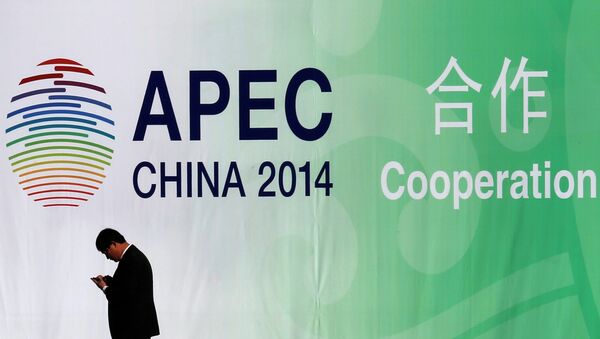MOSCOW, November 9 (RIA Novosti), Alexander Mosesov — As this year's Asia-Pacific Economic Cooperation (APEC) summit is paying particular attention to the energy cooperation given the changing structure of the world energy market, the member countries are considering an increase in liquefied natural gas (LNG) trade in the region.
APEC has a number of working groups within its framework. The LNG trade issue is mostly being discussed by the forum's Energy Working Group (EWG). On September 2, EWG was instructed by the Energy Ministers of APEC member economies to introduce the LNG Trade Facilitation Initiative, aimed at ensuring "the interests of LNG suppliers and consumers" and boosting "the healthy development of APEC natural gas markets".
The LNG Trade Facilitation Initiative was welcomed by the joint APEC ministerial statement, made after the November 7-8 meeting, showing support for the development of the region's LNG market of the forum's member countries' most prominent representatives.
The future of the LNG market development in the Pacific Rim, however, is a very complex one to predict, especially when it comes to the region's largest countries, such as Russia, China and the United States.
LNG IN ASIA-PACIFIC REGION
According to the 2014 LNG report of the International Gas Union (IGU), "LNG trade in 2013 was 236.8 MT, slightly below the record 241.5 MT in 2011," showing the surge of global gas demand while Asia "is expected to be the area of the largest LNG supply growth".
"Global gas demand is surging, nurtured by a growing preference for low-carbon energies and uncertainty over possible Korean and Japanese nuclear policies. The world is keenly awaiting new LNG supplies from the US, although some uncertainty remains over the actual number of liquefaction projects that will start delivering soon," IGU President Jerome Ferrier stated in March.
The IGU report also stated that the profitability of the Asia-Pacific market would be ensured by the growing demand from China.
Director of the Energy Security Initiative at Brookings Tim Boersma shares the same view on the subject. "The share of LNG in Asia is likely to further increase over the coming years and decades. In particular China, India and others have substantial room for growth," Boersma told RIA Novosti Sunday.
US, RUSSIA LNG TRADE PERSPECTIVES WITH CHINA
Since the discovery of major shale gas reserves in the United States, the country, being a major LNG importer, has been actively developing its role as an LNG exporter. And according to Boersma, China could become a potential buyer of US LNG.
"I surely think that US LNG could be sold to Chinese buyers," Brookings Energy Security Initiative director said.
Meanwhile in October, Russia's Rosneft energy company stated it was considering the supply of Russian liquefied natural gas to China with CNPC (China National Petroleum Corporation).
Speaking about Russia's role as a LNG exporter to China, Boersma told RIA Novosti that "Russian LNG will indeed have to compete with other LNG, for instance from Australia and the United States."
The perspective of US-Russian competition on the Chinese LNG market, however, is seen as quite unlikely by the Head of the Center for Energy Security at the Institute for the US and Canadian Studies Andrei Korneyev.
"This [US LNG export to China] is expensive, because it [LNG cargo] will have to be hauled across the Pacific and given the current price drop it would be completely unprofitable," Korneyev told RIA Novosti Sunday.
As for Russia's Sakhalin 2 LNG project, on the contrary, the head of Center for Energy Security said "it is profitable because the gas is hauled to Japan and it is a very short distance." The distance between Russia's Far East and China is also obviously much shorter than the distance between the United States and China.
Korneyev also noted "the United States do not have reserves of natural gas, sufficient for the profitability of such projects, especially given the increasing transportation costs and the rapid depletion of shale gas reserves".
"It is possible to try to scare competitors, it is possible to affect the price factors under the guise of negotiations… but a real long-term stable supply on the basis of American resource base on such a long distance is absolutely unreal," the Russian expert concluded.
With China being the main hope for further LNG trade expansion in the Asia-Pacific, given the current circumstances, Russia's perspectives as an LNG exporter seem to be brighter than those of the United States.
WHAT IS LNG?
LNG is produced from natural gas by means of compression and subsequent cooling. What's very important for the transportation of this fuel is that when liquefied, its volume reduces by about 600 times. However, LNG should be stored at the temperature of —260 °F.
It is obvious that the production of LNG, its storing and subsequent regasification needs serious investments, scientific solutions and the construction of sophisticated infrastructure. That's why LNG has not been so popular in the past, despite having a century-long history.
The scientific progress of the past decades has significantly reduced costs for LNG production, making, for example, gas shipments from Qatar to Japan, obviously impossible via gas pipeline due to geographical reasons, not only possible, but profitable.
Such a tendency, along with the discovery of unconventional gas resources, such as shale gas (gas from shale formations, obtained by means of hydraulic fracturing or fracking), are the two main factors, affecting the liquefied natural gas market of the Pacific Rim.




